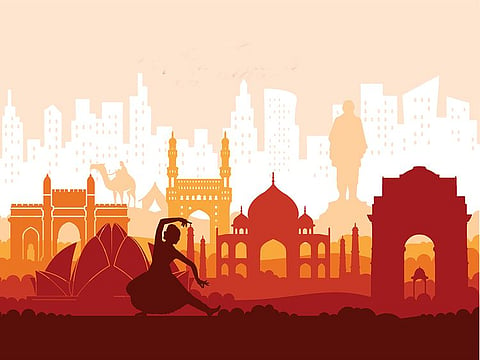The Irish connection to India’s Renaissance
Part III of the series on 75 years of India’s independence

What is striking is the eagerness, even poetic eloquence, with which Sri Aurobindo, the Indian poet, philosopher, and some time political revolutionary, describes the Indian renaissance in 1894, when he was still a young man of twenty-two, in the service of the Maharaja of Baroda. His more considered reflections nearly twenty-five years later were much more sober, if not sceptical.
His later, more mature, series on “The Renaissance in India” consists of four essays first published in in his journal 'Arya' from August to November 1918. At the very outset, Sri Aurobindo refers to James H. Cousins, who also wrote a book, The Renaissance in India, by name, in 1918. Sri Aurobindo’s four-part assessment was thus written partly as an appreciation and response.
Cousins was an Irish poet and Theosophist who come to India in 1915 at the behest of Annie Besant, the firebrand suffragette, socialist, political activist, and president of the Theosophical Society. Besant was also the first woman to serve as the president of the Indian National Congress in 1917. The following year, Cousins had just taken over as the Principal of the Theosophical College at Madanapalle, when he penned The Renaissance in India.
In the eleven chapters in this book, Cousins discusses Indian art, sculpture, painting, poetry, and religion. His main purpose is to promote in India the kind of “redemptive revivalism” that had inspired the Irish not just to assert their spiritual roots in opposition to British materialism, but also to bid for self-determination and independence.
Besant herself used her Anglo-Irish ancestry to champion the cause of Irish freedom from the British Empire. The Theosophists wished to inspire something similar in India, the founder of the Congress, Alan Octavian Hume, being himself a Theosophist for some years.
Cousins declares in his Preface that he wishes “to communicate a larger and deeper comprehension of the spiritual, mental and emotional forces that are moulding the India of near future.”
Like another Englishman C. F. Andrews, an acolyte of Tagore and Gandhi before him, Cousins is at pains to correct the misrepresentations of India in English writings, thus anticipating Edward Said’s critique of Western representations of the non-West in Orientalism (1978).
India's cultural and spiritual unity
More importantly, Cousins is also keen to show that India not only has a cultural and spiritual unity, but that in at least three moments in her past, under the Maurya, Gupta, and Mughal empires, she had achieved political unity too. This was to refute the common perception, assiduously promoted by the British colonial power, that India was not a nation, but a multinational, multi-ethnic, and multicultural subcontinent.
Or, worse, that before the British Empire, India had never achieved political unity. India owes a debt of gratitude to Cousins for refuting such misunderstandings and distortions of Indian history and culture.
Cousins’ book is also valuable as another meaningful attempt at establishing an Indo-Irish connection, which would work in contradistinction to the Indo-British one. Cousins compares the Irish and the Indian situations, speculating on how a cultural nationalism itself was a cosmopolitan phenomenon, capable of proving the ideological basis for emerging states.
According to him the spiritual sources of nationalism were more important than the material; the artist and the poet, by affirming the former, would help lay the basis for a national education and culture, thus preparing the way for the latter.
Decolonising movements in Ireland and India
For Cousins, thus, there was a basic complementarity in the decolonising movements in Ireland and India. Common to both were return to the spiritual roots of a politics of anti-colonialism, a process in which artists and poets had a key role to play.
On his part Cousins himself questioned the term renaissance claiming that Indian culture, though in a state of decline, had not lost its memory altogether. When its continuity was not entirely lost, how could the present revival be called a reawakening?
The Indo-Irish idea of cultural and spiritual nationalism would prove very influential. It stood in clear contrast to international socialism and the materialist political movements against imperialism in countries like China.
India’s spiritual nationalism and contribution to the world of the future became the keynote of Sri Aurobindo’s radically evolutionary thought.
This strand, which had its roots in Bankim Chandra Chattopadhyaya’s writings and in the highly influential career of Swami Vivekananda, later found resonance with cultural nationalists like Deen Dayal Upadhyay, one of the key ideologues of the Rashtriya Swayamsevak Sangh (RSS) and the ruling Bharatiya Janata Party (BJP).
Economic and military self-sufficiency and strength, food and water security, good governance free of corruption and end of dynastic politics, cultural unity and national pride — these are some of the plans and planks on which India’s all-round growth and progress are presaged by the present leadership of India.
Prime Minister Narendra Modi himself has hearkened the next quarter century of India’s independence as a sort of golden age.
But, as I have argued in this column, India’s renaissance is as yet unfinished. Much needs to be done to unlock its fullest potential. In order for this to happen, paying heed to the ideas of Sri Aurobindo, whose 150th anniversary the country is also celebrating, would be salutary.
For it is Sri Aurobindo who articulated most comprehensively the idea of the Indian renaissance, offering nothing short of a blueprint for India’s total transformation.
[To be continued]
Sign up for the Daily Briefing
Get the latest news and updates straight to your inbox



